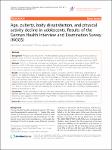Age, puberty, body dissatisfaction, and physical activity decline in adolescents. Results of the German Health Interview and Examination Survey (KiGGS)
Finne, Emily
Bucksch, Jens
Lampert, Thomas
Kolip, Petra
Background: Physical activity (PA) shows a marked decline during adolescence. Some studies have pointed to pubertal status or timing as possible PA determinants in this age group. Furthermore, it was supposed that the impact of pubertal changes on PA might be mediated by psychological variables like body dissatisfaction (BDS). Methods: The 11- to 17-year-old subsample of the German Health Interview and Examination Survey (KiGGS) was used (n = 6 813; 51.3% male, response rate = 66.6%). Through sex-specific sequential multinomial logistic regressions we analysed the univariate and independent associations of chronological age, absolute pubertal status, relative pubertal timing, and BDS with the frequency of PA. Results: Chronological age showed a significantly negative association with PA in both sexes, independent of puberty. The odds of inactivity in contrast to nearly daily PA increased about 70% in boys and 35% in girls for each year of age, respectively. Adjusted for age and other possible confounders, inactivity was significantly less likely for boys in late pubertal stages (OR = 0.27, 95% CI = 0.09-0.78). The risk of inactivity was more than doubled in boys maturing earlier than peers in terms of relative pubertal timing (OR = 2.20, 95% CI = 1.36-3.56). No clear significant puberty effects were found in girls, but the inactivity was more likely for those with irregular menstruation (OR = 1.71, 95% CI = 1.06-2.75). BDS also contributed to the prediction of PA in both sexes. It partially mediated puberty effects in boys but not in girls. Conclusions: Overall, chronological age was a far more important predictor of PA in German adolescents than absolute pubertal status or relative pubertal timing. Further possible explanatory variables like sociocultural influences, social support or increasing time requirements for education should be analysed in conjunction with chronological age in future studies.
Dateien zu dieser Publikation
Keine Lizenzangabe

